
Transcription
WorkFlow Guide Epigentics and DNA MethylationAdvances in Capillary Electrophoresis-Based Methods forDNA Methylation AnalysisMDNA MethylationMethyl groups added to specificDNA bases repress gene activity.eMeCGGCCGMeHistoneHistone ModificationMany different modifications tohistones, including methylationand acetylation, have beenidentified. These modificationscan alter the activity of the DNAwrapped around them.ChromosomeFigure 1. The two main components of the epigenetic code, DNA methylation and histone modificationEpigenetics and DNA MethylationThe term ‘Epigenetics’ describes heritable genetic modificationsthat are not attributable to changes in the primary DNAsequence. Epigenetic modifications play a key role in regulatinggene expression, and therefore are critical to the development,regulation and maintenance of the normal cell. There arethree inter-related forms of epigenetic inheritance: genomicimprinting, DNA methylation and histone modification. Of these,DNA methylation is the most well-characterized epigeneticmodification and forms the focus of this guide.DNA methylation is involved in the regulation of manycellular processes, including X chromosome inactivation,chromosome stability, chromatin structure, embryonicdevelopment and transcription. Aberrant DNA methylation hasbeen associated with many human diseases, including cancer.Patterns of DNA methylation are set during embryogenesisand re-established during early development by DNAmethyltransferase and demethylase enzymes. ‘CpG islands’(cytosine-phospho-guanine) are 300-3000 base pair stretchesof DNA that are CpG rich. CpG islands are often located inthe promoter regions of genes where in the normal cell theyare typically unmethylated, thus allowing transcription. Incontrast, CpGs found outside promoter regions are commonlymethylated, and are believed to be responsible for silencingthe transcription of repetitive sequences and parasiticsequence elements, such as viral DNA. Consequently,aberrant methylation can lead to either silencing of criticalgenes or increased expression of detrimental factors.
erMETHYLCYTOSINETCFigure 2. DNA methylation inhibits gene expression and aberrant methylation has been implicated in many diseases includingA cancerTDNA Methylation AnalysisAs an epigenetic event, methylation is not preservedduring amplification processes such as PCR or whole geneamplification (WGA). Early methods for detecting andmeasuring DNA methylation relied on Southern blot-basedapproaches using methylation sensitive enzymes. Thesemethods, however, have many drawbacks: they require largeamounts of high quality DNA, incomplete restriction digestsare frequent, and they do not target specific regions ofinterest. Bisulfite treatment of DNA transforms an epigeneticevent to a genetic change which is then able to be analyzedusing PCR-based methods. Bisulfite deaminates nonmethylated cytosine residues to uracil, leaving methylatedcytosines unchanged. After PCR, the uracils are convertedto thymine while the methyl Cs are converted to regular Cs.The sample can then be compared to a non-bisulfite treatedsample to identify the methylated sites.Various technologies may be used to analyze bisufitetreated DNA. Microarray and next generation sequencingtechnologies allow for macro-level identification of methylationpatterns, providing clues as to which regions should be furtherelucidated. After identification of candidate regions, capillaryelectrophoresis (CE)-based sequencing is used for validationand remains the gold standard in validating DNA methylationresults. CE sequencing provides detailed information foreach CpG in the entire amplicon and allele-specific haplotypeinformation may be enabled through cloning. AdditionalTCTAGCanalysis techniques of bisulfite treatedDNAinclude fragmentHSO-3analysis using a methylation sensitive mobility shift assay,G anU all TCpGsC acrossT forwhich yields a cumulative answerentire amplicon and Single Base Extension, which providesA statequantitative information on theAmethylationofC anAGindividual CpG. The following pages illustrate the typicalworkflow for methylation analysis, highlighting technicalconsiderations for each step and describing the benefitsof Applied Biosystems solutions for analysis of bisulfiteconverted DNA.TCTCTATAGCHSO-3TUTCGAAAGCPCRTTTCGAAAGCFigure 3. Bisulfite conversion of unmethylated cytosine followed by PCR
1DNA ExtractionDNA Methylation WorkflowDNA ExtractionDescriptionDNA is isolated from various sample types including blood, cultured cells,and tissue (fresh/frozen and formali-fixed-paraffin embedded FFPE).Technical Considerations DNA purity is critical as contaminating protein inhibits bisulfite conversionand PCR FFPE samples are difficult to analyze due to variation in DNA quantity,quality and purityAB SolutionsSingle Tube to 96 Samples- MELT Total Nucleic Acid Isolation for Blood and Cell Cultures- RecoverALL Total Nucleic Acid Isolation from FFPE tissueAutomated Sample Prep- NucPrep DNA Isolation Kit- BloodPrep DNA Isolation Kit Multiple kits for DNA isolation—Applied Biosystems provides several nucleicacid extraction kits to meet a variety of sample type and throughput needs High-quality, high-molecular weight DNA—free from inhibitors of PCR andsuitable for any DNA-based assay High-quality DNA from FFPE samples—RecoverAll Kit is optimized torelease a maximal amount of RNA and DNA fragments of all sizes withtypical yields of 50% that of unfixed tissue from the same sample source120% Samples successfully traldgsSDCCAPCRecoverAllCompetitor QFigure 4. Amplification success rate of bisulfite-modified FFPE-extractedDNA using RecoverAll vs. Competitor Q Kit
121DNA e Conversion3234BisulfiteConversionPrimer Design&AmplificationPrimerDesign AGCHSO-3HSO-3Primer Design &GUCTTAmplificationAAAGCDNA is treated with bisulfite which deaminates unmethylated cytosinesto Uracil.Primers are designed to amplify the regions of interest and PCR amplified. Resin-based purification methods have higher affinity for methylatedDNA, resulting in sample bias Primer design is critical as the converted DNA is difficult to amplify dueto the less complex, 3-base genome- Different Tm calculation- Increased non-specific priming Harsh denaturation processes fragment DNA Incomplete bisulfite conversion leads to false positives Inefficient purification and recovery leads to poor yields Long term stability of bisulfite converted DNA at 4 CBisulfite ConversionPrimer Design- methylSEQr Bisulfite Conversion Kit- Methyl Primer Express Software Amplification- Thermocycler Systems- AmpliTaq Gold Kit Unbiased DNA recovery—methylSEQr Kit enables more accuratedownstream quantitative analysis Less PCR failure—Methyl Primer Express Software algorithm isoptimized for low complexity DNA, providing rapid primer design withless PCR failure Freely available primer design software—Methyl Primer Express Software can be downloaded at www.appliedbiosystems.com/ Optimize PCR conditions for difficult sequences—with the added controlof VeriFlex Blocks, you have six independent temperature blocksproviding precise control over your PCR optimization Figure 5. Peak obtained using methylSEQr Kit demonstrates unbiasedrecovery of methylated and unmethylated fragments whereas peak heightfor unmethylated DNA from the same sample is significantly reduced withCompetitor Q Kit Less fragmentation—methylSEQr provides more high-quality DNA forbetter amplification Higher Yields—methylSEQr provides more high-quality DNA availablefrom minimal starting material Increased sample stability—methylSEQr Kit converted DNA is stable for upto 3 years at 4 CFor more information visit: www.appliedbiosystems.com/methylseqrFigure 6: Veriti 96-Well Thermal Cycler provides independent temperatureblocks for PCR optimization
TCTATAGC3Primer Design hylation events are detected by sequence or fragment analysis. The particularmethod is determined by the level of resolution and quantitation required.5 45DetectionData AnalysisData AnalysisData AnalysisResults are compared to reference sample of non-methylated DNA. Sequencing provides detailed information for each CpG within an amplicon Fragment Analysis yields cumulative information for all CpG’s across anentire amplicon Single Base Extension provides quantitative results for a particular CpG Methylation information across entire CpG island not just one CpG—asingle CpG may not represent methylation status and capture the resultingimpact on gene expression. May have biologically relevant differentialmethylation of CpGs across an island that needs to be characterized. Sequencing algorithms overcompensate for low complexity3-base genome and skew data Limited analysis tools for methylation Quantitative result to understand the %methylation in mixed samples Bisulfite converted DNA is difficult to sequenceBisulfite Sequencing- Variant Reporter Software- BigDye Terminator Sequencing Kits- SeqScape Software- BigDye XTerminator Purification Kit- Genetic Analysis SystemsFragment Analysis- GeneMapper Software v4.0- GeneScan 600 LIZ Size Standard- Genetic Analysis SystemsSingle Base Extension- GeneMapper Software v4.0- ABI PRISM SNaPshot Multiplex Kit- GeneScan 120 LIZ Size Standard- Genetic Analysis Systems More information—sequencing provides detailed information for each CpGacross an entire amplicon and allele-specific haplotype is enabled via cloning More accurate base calling—KB Basecaller algorithm adjustsfor sequences with skewed base composition in such a waythat underrepresented colors are not artificially exaggerated,providing cleaner traces and more accurate methyl C callsFigure 7. Differential methylation patterns shown over the entire island More accurate detection—CE sequencing provides direct detectionof DNA methylation without reliance on enzyme or probe affinity In a sample control of bisulfite conversion—sequencing identifieserroneous data from incomplete bisulfite conversion Gold Standard Sequencing—highest quality products provide theperformance needed for difficult sequences Multiple analyses from single reaction—converted DNA can be carriedforward into fragment analysis, sequencing and SBE experiments Fragment analysis is a rapid and inexpensive method to assess thedegree of methylation present in a given ampliconFigure 8: Comparison of basecalling algorithms
ReferencesBisulfite conversion of genomic DNA for methylation analysis: protocolsimplification with higher recovery applicable to limited samples and increasedthroughput. Boyd et.al. Anal Biochem. 2004 Mar 15;326(2):278-80Recovery of bisulfite-converted genomic sequences in the methylation-sensitiveQPCR. Munson et.al. Nucleic Acids Research, 2007, 35 (9): 2893-903Methylation-dependent fragment separation: direct detection of DNAmethylation by capillary electrophoresis of PCR products from bisulfiteconverted genomic DNA. Boyd et.al. Anal Biochem. 2006 Jul 15;354 (2): 266-73Single nucleotide extension technology for quantitative site-specificevaluation of metC/C in GC-rich regions. Kaminsky et.al. NucleicAcids Res. 2005 Jun 15;33(10):e95ResourcesMethylation Application onBisulfite Sequencing ups/mcb marketing/documents/generaldocuments/cms 039258.pdfMethyl Primer Express xpressProduct Ordering InformationDescriptionPart NumberSample PrepMELT Total Nucleic Acid Isolation SystemAM1983RecoverAll Total Nucleic Acid Isolation Kit for FFPEAM1975BloodPrep DNA Starter Kit4346860NucPrep DNA Isolation Chemistry Starter Kit4340274 Bisulfite ConversionmethylSEQr Bisulfite Conversion Kit4379580Primer DesignMethyl Primer Express Software v1.0Free downloadPCRVeriti 96-Well Thermal Cycler4375786AmpliTaq Gold DNA Polymerase4311814 SequencingBigDye Terminator v3.1 Cycle Sequencing Kit4337455BigDye Terminator v1.1 Cycle Sequencing Kit4337450BigDye XTerminator Purification Kit4376486Applied Biosystems 3130xl Genetic Analyzer3130XL Single Base ExtensionABI Prism SNaPshot Multiplex Kit4323151Fragment AnalysisGeneScan 600 LIZ Size Standard4366589GeneScan 120 LIZ Size Standard4324287 Data AnalysisSeqScape Software v2.5, 45-Day Demo4327099GeneMapper Software v4.0, 30-Day Demo4366851Variant Reporter Software v1.0, 30-Day Demo4385270 For Research Use Only. Not for use in diagnostic procedures.Applera, Applied Biosystems, AB (Design), ABI Prism, BloodPrep, BigDye, GeneMapper, LIZ, NucPrep, Primer Express, SeqScape, and SNaPshot are registered trademarks andGeneScan, KB, methylSEQr, Variant Reporter, VeriFlex Blocks and Veriti are trademarks of Applera Corporation or its subsidiaries in the US and/or certain other countries. MELTand RecoverAll are trademarks of Ambion, Inc. Ambion is a wholly-owned subsidiary of Applera Corporation.All other trademarks are the sole property of their respective owners. 2007. Applied Biosystems. All rights reserved.Printed in the USA. 08/2007 Publication 106BR14-01Headquarters850 Lincoln Centre Drive Foster City, CA 94404 USAPhone 650.638.5800 Toll Free 800.345.5224www.appliedbiosystems.comInternational SalesFor our office locations please call the divisionheadquarters or refer to our Web site atwww.appliedbiosystems.com/about/offices.cfm
Primer design is critical as the converted DNA is difficult to amplify due to the less complex, 3-base genome - Different Tm calculation - Increased non-specific priming Primer Design - Methyl Primer Express Software Amplification - Thermocycler Systems - AmpliTaq Gold Kit Less PCR failure—Methyl Primer Express Software algorithm is










